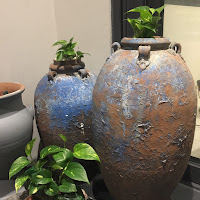Beautiful and well-composed Instagram plant posts with lush greens in luxe pots make you want to DM their online shop and shop all their products for your home. But unlike home furniture, having plants that thrive in your home requires some effort and attention that varies with each plant type.
If you’re planning to start your plant parenthood journey, I highly recommend these 3 resilient plants that will ease you into the responsibility of caring for Momma Nature’s leafy babies:POTHOS
I grow the Golden Pothos species (Epipremnum aureum) in my home. I found several clay jars in our Fixer Upper but I didn’t to use them for fear that they’ll be mosquito breeding grounds or hiding spots for lizards, the latter I’m deathly afraid of. Then I had a light bulb-moment to plug the jar mouths with small pots of Golden Pothos. My parents supported the idea and brought cuttings from their garden. I’m happy to report that they are thriving and now cascading down the jars, achieving the look that I was going for!

This group of plants belong to the Araceae family, cousins of anthuriums, philodendrons, and peace lilies. It is also referred to as Devil’s Ivy because of its die-hard nature even when kept in the dark. It thrives in low light and humidity while purifying the air of pollutants (like formaldehyde, trichloroethene, toluene, xylene, and benzene) and can withstand long periods of neglect. This makes it well-suited for offices and condominiums. Its vine-like habit makes it suitable for beautifying tall bookshelves that allow its heart-shaped leaves to cascade down. It can be grown out of soil or water. You can opt to just water it only when the soil is dry.
SANSEVIERIA
More commonly known as Snake Plants or Mother-in-Law’s Tongue, Sansevieria belong to Asparagaceae family. It is a perennial plant whose plant fibers were once used to make bowstrings, earning another name, Viper’s Bowstring Hemps. Like Pothos, it makes for a good indoor plant because it tolerates low light and irregular watering, and in fact, will rot easily if overwatered. The NASA Clean Air Study discovered that the species Sansevieria trifasciata has impressive indoor air filtration qualities, removing 4 of 5 toxins associated with Sick Building Syndrome. This makes the Sansevieria a perfect plant for those of you who spend a great deal of time in the office, or live in a condominium.

I have several pots of Sansevieria trifasciata at our home. I have tall ones, and shorter ones called Bird's Nest. I love how the tall spiralling vertical leaves look like underwater seaweed moving in the water. Sometimes I get over eager with watering these plants, and the succulent leaves start to soften dangerously. Thankfully, I simply have to move them outdoors on sunshine rotation and stop myself from watering. Tsk, tsk.
PHILODENDRON
If you were able to keep the Pothos and Sansevieria alive, time to level up to the Philodendron! The name Philodendron is derived from the Greek words Philo which means love, and Dendron for tree. Philodendrons comprise the second largest group in the Araceae family, next to the family of anthuriums. From my experience, Philodendrons need more attention than the previous 2 plants I mentioned and require bigger space. These plants require bright, indirect sunlight and need to dry out between waterings. Leaves become droopy when you overwater and underwater, making it a little bit tricky to figure out what’s going on by just eyeballing the plant.
I have 3 species in my care: the Philodendron giganteum, Philodendron selloum, and Philodendron melinonii. I’ve had them for 6 months now, and I love how they give our living area a rainforest feel. They look like giant green elephant ears that have a beautiful, waxy shine that make my kids suspicious that my plants are fake.
Whichever plant you choose to start your plant parenthood journey with will be beneficial to your home. Best of luck and happy plant parenting! 🌿
#DomesticGoddessMNL








